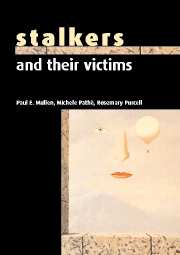Book contents
- Frontmatter
- Contents
- Acknowledgements
- Introduction
- 1 Stalking – a new categorization of human behaviour
- 2 The epidemiology of stalking
- 3 The victims of stalkers
- 4 Classifying stalkers
- 5 The rejected stalker and the resentful stalker
- 6 The predatory stalker
- 7 Intimacy seekers and incompetent suitors
- 8 The erotomanias and the morbid infatuations
- 9 Same gender stalking
- 10 Stalking by proxy
- 11 False victims of stalking
- 12 Stalking and assault
- 13 Reducing the impact of stalking
- 14 Defining and prosecuting the offence of stalking
- 15 Assessing and managing the stalker
- Appendix A Victim services
- Appendix B Important anti-stalking Acts/statutes
- Legal cases and references
- Index
15 - Assessing and managing the stalker
Published online by Cambridge University Press: 05 March 2012
- Frontmatter
- Contents
- Acknowledgements
- Introduction
- 1 Stalking – a new categorization of human behaviour
- 2 The epidemiology of stalking
- 3 The victims of stalkers
- 4 Classifying stalkers
- 5 The rejected stalker and the resentful stalker
- 6 The predatory stalker
- 7 Intimacy seekers and incompetent suitors
- 8 The erotomanias and the morbid infatuations
- 9 Same gender stalking
- 10 Stalking by proxy
- 11 False victims of stalking
- 12 Stalking and assault
- 13 Reducing the impact of stalking
- 14 Defining and prosecuting the offence of stalking
- 15 Assessing and managing the stalker
- Appendix A Victim services
- Appendix B Important anti-stalking Acts/statutes
- Legal cases and references
- Index
Summary
Introduction
Approaches to managing stalking behaviours have been discussed at various points in the book, most particularly in the chapters on the stalker typology and on erotomania. The focus has been, to this point, almost exclusively on how best to end the stalking behaviours. The extent of the disruption that stalking brings to the life of the perpetrator as well as the victim has been acknowledged but rarely given attention. Sympathy for the stalker is not a proposition with immediate appeal. And yet these are often a lonely, inadequate, disturbed, if not frankly mentally ill, group of human beings. Their stalking reflects a range of influences among which can be remediable mental disorders as well as modifiable characterological and social skills deficits. Furthermore, it is the distress and disruption experienced by the stalkers that can potentially be used as a lever to alter their behaviour and release the victims from continuing distress and disruption.
A false dichotomy is often created in the management of mentally disordered offenders between the social imperatives of prevention and punishment and the health responsibilities of treatment and care. The issue of how to respond to a mentally abnormal offender is sometimes presented as a choice between either responding to the claims of the victim and the wider society or responding to the needs of the offender.
- Type
- Chapter
- Information
- Stalkers and their Victims , pp. 279 - 288Publisher: Cambridge University PressPrint publication year: 2000



